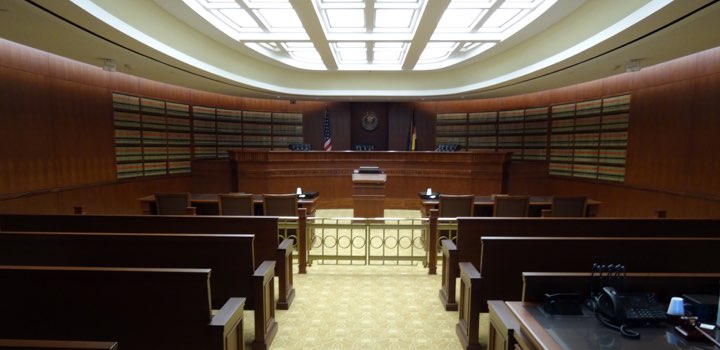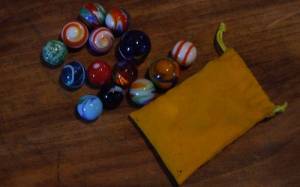Examining Axanar's Claims About Infringement, Damages
Table of Contents
Does Fan Film Factor‘s Analysis Hold Up to Scrutiny?
Analysis

By Carlos Pedraza
AxaMonitor editor
October 27, 2016
In the wake of a court ruling compelling CBS and Paramount to turn over some of the records sought by his defense attorneys, Alec Peters’ approved blog for speculating on the lawsuit went into high gear, portraying the order as putting Axanar in a “legally advantageous” position.
In a four-part series, “Axanar Lawsuit Discovery Ruling — What Does it All Mean?” Axanar surrogate Jonathan Lane described the October 21, 2016, ruling by Federal Magistrate Judge Charles F. Eick as a major victory for Axanar’s defense in the copyright infringement lawsuit it faces by the studios that own Star Trek.
Lane writes the Fan Film Factor blog, which has become the place through which Axanar releases information or provides exclusive interviews. Proscribed from too much public discussion about his lawsuit, Peters has told Axanar supporters that Lane’s blog is “the one location [where] you can get the inside scoop on the Axanar lawsuit [and] the only legitimate news source on the Axanar lawsuit online,” claiming Lane’s coverage was “unbiased and knowledgeable.”1)
Civil lawsuits aren’t won by the side that obtained the most evidence, but by the one whose case is better grounded in the law.
A Big Win?
Despite the court officially describing its order as only “partially granting and otherwise denying [the] motion to compel discovery,” Lane characterized the judge’s decision as a “big win for Axanar during the discovery phase.”2)
All the Marbles
Lane likened Axanar’s win to getting 85 of the 100 marbles it wanted, and to a chess game in which the defense cleverly sacrificed some its pieces in order to win the game. However, lawsuits aren’t won by the side that obtained the most evidence, but by the one whose case is better grounded in the law (see ”Burden of Proof,“ below).
Even the anonymous attorney Lane quoted pointed out that CBS and Paramount’s lawyers were likely not surprised by the outcome of the discovery hearing; both sides were playing chess, and Axanar’s win wasn’t anywhere close to checkmate:
The defense went after way too much, hoping that by asking for a mountain, they’d at least get a mole hill. The plaintiffs took a chance that they could weasel out of having to produce most of what the defense was asking for. It was worth a shot, and some judges might have let them get away with some or most of what they wanted to withhold. But other judges will rule the other way, and as I said, I’m not surprised by this outcome. I doubt the plaintiffs’ lawyers are all that surprised either. Disappointed, maybe. But they had to know this was a big gamble to begin with.3)
LAWSUIT PRIMER Get an overview of the copyright lawsuit, including a timeline of the case, as well as downloadable pleadings made by the plaintiffs, CBS and Paramount, and defendants Alec Peters and Axanar Productions Inc. » Lawsuit Primer
Reading the Judge's Mind
Lane argued that one of the judge’s statements betrayed his feelings about “how damaging turning this information over could be to the plaintiffs. After all, this is their playbook. When they go to trial, they will attempt to prove financial harm. So the judge has just ordered the studios to explain exactly how they’re going to do that in court so the defense can prepare to counter it. But in law, that’s perfectly fair.”4)
PARTLY TRUE Lane is perfectly correct that the judge granted the defense’s requests in the interest of fair play, but that’s a far cry from assuming Eick was making a qualitative determination about how “damaging” the evidence might be. His interest is in ensuring both sides get all the evidence they’re entitled to in order to build the case they want. That interest has nothing to do with judging how effective that case will be when all is said and done. That’s up to the jury and/or the trial judge, R. Gary Klausner, to eventually decide.
Bounty of Information
By all accounts, Axanar’s lawyers were granted significant information in the judge’s order, which Lane described as a “newfound ‘bounty’ (an amazing amount of new discovery documentation and verbal/written answers to defense questions ordered by the court).”5)
Building Axanar's Case
As Axanar attorney Erin Ranahan explained the motion to compel discovery, lack of harm goes to the heart of the defense case, especially with regard to fair use, namely:
- No harm from Axanar. Prelude to Axanar, distributed for free what she called the “non-commercial” feature film, Axanar, posed no financial threat to CBS and Paramount.6)
- Tolerated use. The studios “long tolerated and encouraged … Star Trek-inspired works of fan fiction.”7)
- No harm from fan films. The studios’ “tacit acknowledgement that works of fan fiction such as the Axanar Works have no negative impact” on Star Trek’s market, leading any possible infringement to likely be innocent.
- Statutory damages. Little or no need for statutory damages from whatever copyright infringement the plaintiffs might prove.
The Two Pillars
Lane’s recounting of the defense case rests on two pillars:
« Axanar’s argument, ‘We’ve earned so little compared to your billions,’ essentially claims stealing is OK so long as you do it to someone rich. »
- Minimal actual damages
- Innocent infringement
However, as explained by Lane, those concepts miss important aspects of copyright law.
Actual Harm
Market harm is only one of the four factors to be weighed in a fair use analysis, and while it’s important, market harm and actual damages are not synonymous, and Lane seems to be equating the two.
Lane characterized the plaintiffs’ case for damages as ‘actual’ first and ‘statutory’ as a fallback. But the pleadings don’t back up that interpretation. In fact, the law gives the plaintiffs, even up to the time that judgment is rendered, the choice of electing statutory damages instead of actual.8) Of course, for the defense, focusing on actual damages allows them to minimize the infringement while amplifying the defendants’ hopes for a ruling of fair use.
Defendants’ Burden. In a copyright case, it’s the violation of the exclusive rights of the copyright holder that is the harm, and any profits obtained by the defendant are presumed to be damages. All the plaintiff has to introduce into evidence are the defendants’ gross revenues (which is why winning the financial summaries in the motion to compel really isn’t that big a deal; it’s standard for cases like these). It is the defendants’ burden to winnow the financial impact down to “profits attributable to the infringement,” not the plaintiffs’.
Furthermore, Lane focuses on the notion that market harm is only something that you can judge retrospectively; in other words, looking back at Star Trek’s financials and trying to assess the harm they suffered because of Axanar. But market harm is also about assessing the potential future harm to the copyright holder. CBS and Paramount are arguing that allowing unlicensed productions to create their own works based on Star Trek — and to earn money from them — harms their potential market.
Stealing From the Rich. Axanar’s argument, “Oh, but we’ve earned so little compared to your billions,” is disingenuous, essentially claiming that stealing must be OK so long as we’re doing it from someone who’s rich.
The very essence of copyright is that no one gets to control your intellectual property but you; no one gets to earn income from your intellectual property but you. Fair use is the exception that proves the rule.
Innocent Infringement
Lane further argued that winning the case would prove only a pyrrhic victory for the studios; the burden is on them to prove that Peters willfully infringed, and short of that the statutory damages fall well below the $150,000 the plaintiffs could claim per instance of willful infringement.
Lane asserts that willfulness requires reading Peters’ mind and since no one can do that, he has a stronger case. Trouble is, copyright law acknowledges it’s impossible to read an infringer’s mind in order to establish willful intent to infringe. That’s why the standard of proof is acknowledged from the get-go to be circumstantial — gathering sufficient evidence that Peters should have known, and that a reasonable person, seeing all the facts, would conclude similarly. The “but all the other kids were doing it, too” argument won’t take the defendants very far.
Preponderance of Evidence is the standard in a civil case by which a jury and/or judge decide in favor of one side or the other. This preponderance is based on the more convincing evidence and its probable truth or accuracy, and not on the amount of evidence.9)
Burden of Proof
Also, it’s important to remember that this is a civil case. The plaintiffs don’t have to prove Peters’ willful infringement beyond a reasonable doubt as in criminal cases; they only have to do so by a preponderance of evidence. The plaintiffs may start with the intellectual property class Peters likely took in law school and work their way through his blogs, forum posts, podcasts and media interviews, as well as testimony from depositions.
Financial Incentive
Finally, Lane continued to portray the lawsuit as a loser for CBS and Paramount because they likely will see little money from Axanar were the studios to win. The trouble is, it’s not clear CBS and Paramount are after money. Since they received a copy of Axanar’s financial audit, they now know how much (or little) money Axanar has. They’re after a judgment that sends a clear message: Producers of unlicensed films aren’t allowed to personally earn money off our intellectual property; claiming you’re fans who love our IP doesn’t give you the right, even claiming fair use, to do so.
It’s worth it to the studios to spend the hundreds of thousands this lawsuit will likely cost them to send that message. Not simply to Peters, who eventually fades away, but to anyone who thinks they can set up a commercial venture under the auspices of their “love for the franchise.” Even the staunchest fair use/transformative works people acknowledge that there’s a line you don’t cross, and the studios aim to prove by a preponderance of evidence, that Axanar crossed that line. A lot. 
Keywords

